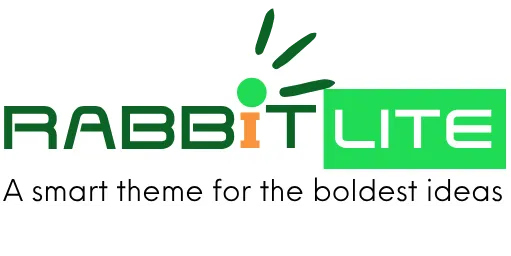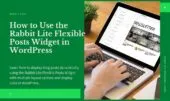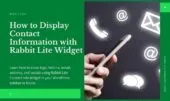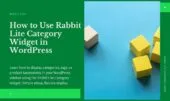- 1. How to Use the Rabbit Lite WYSIWYG Widget
- 2. Key Features of the WYSIWYG Widget for WordPress
- 3. How to Add the Rabbit Lite WYSIWYG Widget
- 4. Configure the WordPress Visual Editor Widget
- 4.1. Widget Title in a Custom Content Widget
- 4.2. Enable Title in Sidebar WYSIWYG Content
- 4.3. Insert Rich Text Content with the Editor Widget
- 4.4. Using the Multilingual Widget in Rabbit Lite
- 5. Use Cases for the Add Media Widget
- 6. Style Tips for a WordPress Widget with Editor
- 7. Best Practices for a WYSIWYG Widget WordPress Setup
- 8. Fixing Issues with the Visual Editor Widget
- 9. Conclusion: Custom Content with Rabbit Lite WYSIWYG Widget
The Rabbit Lite WYSIWYG widget provides a powerful way to display rich content directly in your sidebar or any widget area. It’s especially useful when you want to add formatted text, media, or shortcodes without writing HTML manually.
Unlike many other wysiwyg widget WordPress plugins, this widget is lightweight, fully compatible with the block editor, and doesn’t require third-party extensions. You can use it to build a custom content widget that supports visual editing, shortcodes, and even multilingual content.
Whether you’re managing content for blogs, landing pages, or product sidebars, the WordPress visual editor widget from Rabbit Lite offers a familiar and flexible editing experience—directly inside the widget settings.
How to Use the Rabbit Lite WYSIWYG Widget
The Rabbit Lite WYSIWYG Widget lets you add formatted text, media, and multilingual content directly into widget areas. It’s ideal for inserting custom HTML, images, or shortcodes without editing theme files.
You can:
- Add formatted text and headings with a familiar WordPress visual editor interface.
- Insert media like images or videos via the Add Media button.
- Create multilingual content using language filters.
- Show sidebar content for announcements, author info, or calls to action.
- Use shortcodes for contact forms, recent posts, or CTAs.
- Add custom content in footers, sidebars, or other widget areas.
- Support custom HTML, inline CSS, or embeds with preview.
- Manage content per widget without global settings or extra plugins.
- Use multilingual setups by duplicating widgets per language with conditional logic.
This lets you build flexible, rich-content widget layouts for blogs, business sites, or multilingual Rabbit Lite websites.
Key Features of the WYSIWYG Widget for WordPress
The Rabbit Lite WYSIWYG widget allows easy addition of formatted content in sidebars or widget areas through a visual editor. It helps users insert custom HTML, text, images, or links without coding.
- Visual editing: Use the familiar WordPress editor to format content, create headings, lists, or links.
- Media insertion: Upload or select images, PDFs, or audio from the Media Library.
- Multilingual support: Integrates with translation tools for multilingual sites.
- Custom blocks: Add announcements, messages, or design sections.
- Rich text: Insert styled text like bold or italic, similar to post editing.
- Sidebar use: Place in sidebars or footers without editing theme files.
- Reusable content: Save and reuse content blocks across your site.
- HTML support: Switch to Text tab for raw HTML input.
- Theme friendly: Works with Rabbit Lite and standard WordPress editor-compatible themes.
How to Add the Rabbit Lite WYSIWYG Widget
Adding the Rabbit Lite WYSIWYG widget allows you to display formatted content directly in any widgetized area, such as sidebars or footers. This is useful for adding rich text, media, or multilingual content without coding.
To add the Rabbit Lite WYSIWYG widget in WordPress:
- Go to Appearance > Widgets in your WordPress admin dashboard.
- Look for the widget labeled Rabbit Lite WYSIWYG Widget in the available widgets list.
- Drag and drop it into your desired widget area (sidebar, footer, or any widget-ready zone).
- A visual editor will appear, allowing you to:
- Insert formatted text and headings using the WordPress visual editor.
- Add media files (images, videos, documents) using the standard WordPress Media Library.
- Include custom HTML if needed for layout control.
- Create multilingual content if you use language-specific widget areas.
- Click Save after customizing your content.
This method works with all standard themes and supports any custom content widget requirement. It offers full compatibility for those needing a WordPress visual editor widget, or a sidebar WYSIWYG content block for displaying announcements, CTAs, or formatted information.
Configure the WordPress Visual Editor Widget
After adding the Rabbit Lite WYSIWYG widget, you can customize its settings to control how your content appears on the front-end. The widget offers options to set a title, toggle its display, and insert rich content using the built-in WordPress visual editor.
This section explains the key configuration options available for this custom content widget and how to manage multilingual content when using Rabbit Lite’s language features.
Widget Title in a Custom Content Widget
The Rabbit Lite WYSIWYG widget allows you to add an optional title to your widget content. This title helps organize and label content sections when displayed on the front-end, improving clarity for site visitors.
Key points about the widget title include:
- The title field accepts plain text and can be customized per widget instance.
- The title visibility can be controlled by the “Display title” checkbox.
- Displaying the title is useful when the widget acts as a sidebar wysiwyg content block that requires clear section headings.
- Titles are compatible with multilingual setups, showing the correct language when used in a multilingual widget context.
- Managing the title separately from content supports better layout control in themes supporting the wordpress widget with editor standard.
- Using a clear, concise title improves user navigation and accessibility without affecting the rich text content.
Enable Title in Sidebar WYSIWYG Content
The Rabbit Lite WYSIWYG widget includes an option to show or hide the widget title on the front-end. This feature allows precise control over how titles appear within your sidebar or other widget areas, supporting a cleaner design and better content organization.
Important aspects of enabling the title display:
- The “Display title” checkbox toggles the visibility of the widget’s title in the front-end output.
- Enabling the title supports clear section labeling within sidebar wysiwyg content, improving user navigation.
- This setting works seamlessly with multilingual configurations, showing the correct title in each language for a multilingual widget setup.
- When used with themes that support the wordpress widget with editor standard, this feature integrates well without disrupting the overall layout.
- Disabling the title hides the heading but retains the rich text content entered in the insert rich text widget area.
- This option provides flexibility for different design needs, such as minimalistic sidebars or detailed content blocks.
Insert Rich Text Content with the Editor Widget
The Rabbit Lite WYSIWYG widget enables users to add rich, formatted content directly within widget areas using the built-in WordPress visual editor. This capability eliminates the need for manual HTML coding, allowing for flexible and dynamic content creation in sidebars, footers, or other widget-ready sections.
Key features of inserting rich text content include:
- The widget uses the standard WordPress visual editor widget interface (TinyMCE), familiar to most WordPress users.
- Users can insert rich text widget content with options for bold, italic, underline, headings, lists, and links.
- Media files like images, videos, and audio can be added easily through the add media widget button integrated into the editor.
- Supports HTML editing via the Text tab for users needing custom markup beyond the visual interface.
- Enables the creation of sidebar wysiwyg content that is fully styled and responsive according to the active theme’s CSS.
- Works seamlessly as a custom content widget, supporting diverse use cases such as announcements, contact information, or promotional messages.
- Compatible with multilingual environments, allowing content variations for different languages in a multilingual widget setup.
- Integrates well with themes that follow the wordpress widget with editor standard, ensuring consistent display and functionality.
Using the Multilingual Widget in Rabbit Lite
The Rabbit Lite WYSIWYG widget supports multilingual content management by allowing you to input and display separate content for each language. This functionality is essential for websites serving diverse audiences who require localized sidebar or widget content.
Key points for using the multilingual widget include:
- When multilingual mode is enabled, the widget displays distinct content fields for each supported language.
- Each language field uses the WordPress visual editor widget interface, enabling formatted text and media insertion per language.
- The widget automatically detects the user’s current language and shows the corresponding sidebar wysiwyg content on the front-end.
- This system avoids duplicating entire widgets, streamlining management of custom content widget data across languages.
- Media files can be inserted independently in each language using the integrated add media widget functionality.
- Content input supports rich formatting options consistent with the insert rich text widget capabilities.
- Compatibility with translation plugins ensures smooth integration in multilingual WordPress setups.
- This approach adheres to the wordpress widget with editor standard, maintaining consistent display and editing experience across languages.
Use Cases for the Add Media Widget
The Rabbit Lite WYSIWYG widget includes an integrated add media widget feature, allowing you to insert images, videos, and other media files directly within your widget content. This capability enhances the flexibility and visual appeal of sidebar or footer sections.
Common use cases for the add media widget include:
- About Section: Add an introduction with images and formatted text to provide context or biography.
- Promotional Banners: Display styled product images or announcements with embedded media.
- Legal Notices: Insert privacy policies, terms, or disclaimers alongside media elements for emphasis.
- Contact Information: Include maps, icons, or photos to improve user engagement and clarity.
- Event Highlights: Showcase event flyers, schedules, or videos within sidebar content.
- Call-to-Action Blocks: Combine text with media to create visually compelling CTAs.
- Multilingual Content: Add language-specific media files when using the widget as a multilingual widget.
Style Tips for a WordPress Widget with Editor
The Rabbit Lite WYSIWYG widget lets you style widget content easily. Good styling keeps your sidebar content clean and in sync with your theme.
Tips:
- Use Add Media to insert relevant images or videos.
- Wrap text in semantic tags like
<p>or<div>for better structure. - Add CSS classes to match your theme design.
- Avoid too much inline CSS—use theme styles instead.
- Check how content looks on different screen sizes.
- Use Rabbit Lite’s built-in CSS helpers for spacing and layout.
- Apply headings, lists, or blockquotes to organize content.
- Make sure embeds and third-party content are responsive.
- Preview changes often to keep the layout clean.
Best Practices for a WYSIWYG Widget WordPress Setup
Setting up the Rabbit Lite WYSIWYG widget properly helps your sidebar content stay clean, consistent, and multilingual-ready.
Tips to follow:
- Keep content short to avoid clutter and improve readability.
- Limit media usage to keep page loads fast.
- Always preview content on different screen sizes.
- For multilingual sites, check each language version carefully.
- Avoid too much inline CSS—use theme or custom classes.
- Update content regularly to keep it relevant.
- Use clear titles when enabling the “Display title” option.
- Test for theme and plugin compatibility.
- Back up settings before updates or theme changes.
- Follow the WordPress widget with editor standard for consistency.
Fixing Issues with the Visual Editor Widget
If your WYSIWYG widget isn’t working, try these quick fixes:
- Changes not saved: Always click “Save” after editing. Avoid fast switching between text and visual modes.
- Missing toolbar: Reload the page. Disable any browser extensions that might block scripts.
- Layout looks broken: Remove extra spacing or large elements. Preview before saving.
- No content showing: Check if the widget is placed in a visible sidebar and not hidden.
- Media not visible: Recheck the image or video URL. Re-insert if needed.
Most issues can be solved without coding. For ongoing problems, refer to your theme’s support or documentation.
Conclusion: Custom Content with Rabbit Lite WYSIWYG Widget
Using a visual editor widget helps you display flexible content without writing any code. Whether you’re adding a short announcement, custom HTML, or formatted text, the WYSIWYG editor gives you full control.
For bloggers, small business owners, or anyone managing their own site, this widget is a quick way to customize your sidebar or footer areas. It’s easy to update, and works well with your site’s style.
If you’re building with Rabbit Lite, the built-in WYSIWYG widget offers a simple, effective way to add custom content blocks where you need them.









